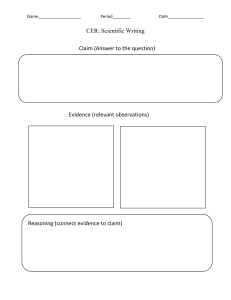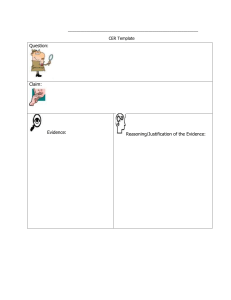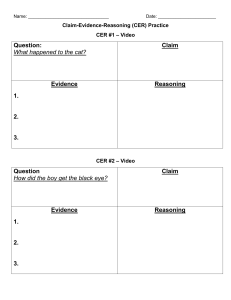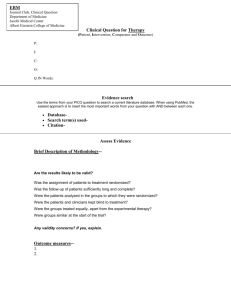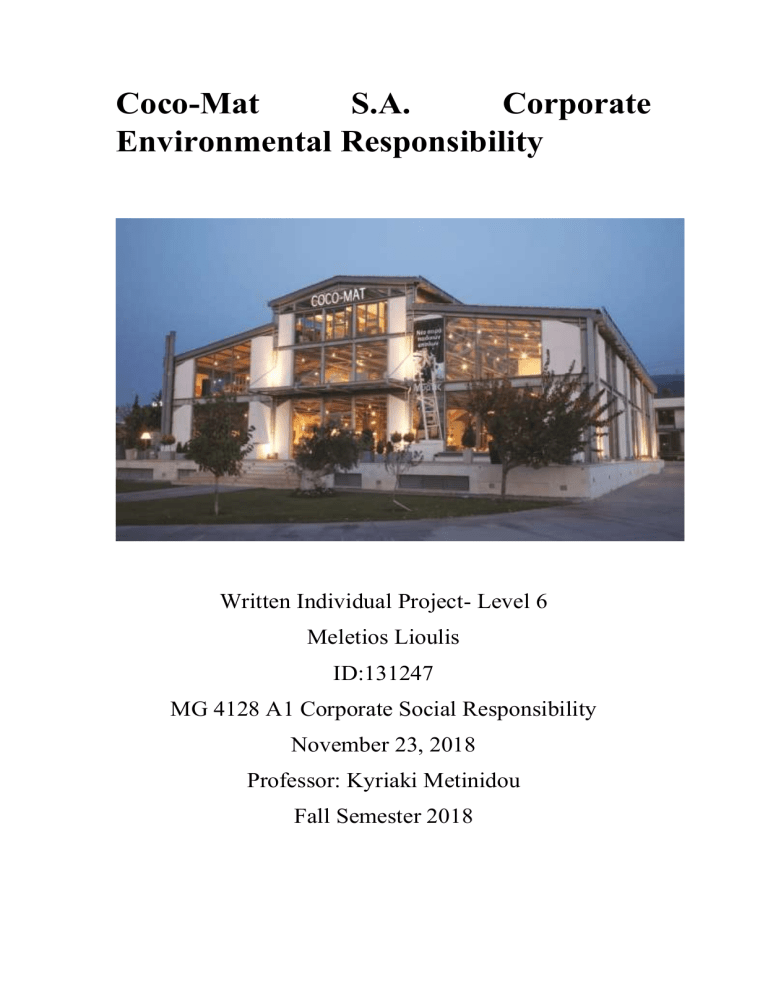
Coco-Mat S.A. Corporate Environmental Responsibility Written Individual Project- Level 6 Meletios Lioulis ID:131247 MG 4128 A1 Corporate Social Responsibility November 23, 2018 Professor: Kyriaki Metinidou Fall Semester 2018 Table of Contents Introduction ................................................................................................................... 3 Corporate Environmental Responsibility ........................................................................ 3 CER Stages ...................................................................................................................... 4 Environmental Management in Practice (EMPs) ............................................................ 5 Top Management Commitment and Leadership .................................................... 5 Clear Goals and Metrics .......................................................................................... 6 Employee Engagement ........................................................................................... 6 Rewards and Incentives .......................................................................................... 6 Environmental Monitoring, Auditing, and Reporting .............................................. 6 Environmental Partnerships.................................................................................... 7 COCO-MAT Case Study ................................................................................................... 7 Conclusion ...................................................................................................................... 9 References.................................................................................................................... 10 Acronyms...................................................................................................................... 11 Appendix 1 ................................................................................................................... 12 Appendix 2 (Interview Questions) ................................................................................ 13 Introduction According to the expanding mindfulness on fundamental issues, and the greatness of expenses related, it has turned out to be essential for organizations to coordinate environmental endeavors into their business methodology. There is a developing awareness among associations on preservations and ideal use of natural assets to increase also competitive advantage through corporate environmental responsibility (Hart, 1995). As a result, the green part of CSR is characterized as an obligation to cover the natural implications of the organization's activities, items, and offices, reduce waste, augment the effectiveness of its assets, and minimize activities that burden the environment. This project will investigate the stages and the management practices concerning Corporate Environmental Responsibility (CER) within an organization. Moreover, the project will be examining the costs, benefits, and the approaches that a company have to take into consideration the application of Corporate Environmental Responsibility. COCO-MAT S.A Athens profile has been picked, with the end goal to have more extensive and more precise information. Human Resource manager Eugenia Liannou has directed orderly qualitative research. Corporate Environmental Responsibility Corporate environmental responsibility as examined by Jamison et al. (2005), considering natural duty, whereby the organization completely enfold and has a net positive effect on condition and society. Partner commitments such as stakeholders with full straightforwardness and responsibility, and a procedure to connect with and enable stakeholders are punctuated. Generally, CER can be portrayed as precautionary measures and arrangements that companies receive to decrease and forestall risks for the environment (Kusku, 2007), alongside stakeholder's support to initiate transparency. It fits well for organizations to be environmental accountable in light of their several substantial and insubstantial benefits (Hansen and Mowen, 2007). According to this event, companies implement programs concerning corporate environmental responsibility. The developing countries tend to focus on the material well being according to Dasgupta et al. (2000) arguments, consequently at the first ages of development, and pollution is an effect that can be referred as agreeable according to economic growth. However, in developed countries that have to accomplish an adequately high standard of living, environmental enactment is achieved, foundations for the insurance of conditions are introduced, and nature quality strides through higher implementations of practices and innovative technologies about manufacturing goods. Some firms do not follow the protocol to implement their responsibilities for the environment if the fines of violating environment are smaller than the cost of compliance (Kusku 2007). As a result, some challenges differ from a developing country to a developed country. Also, strategies and environmental approaches of associations vary from the way to implement them from country to country. The literature review on this paper continues to explain the stages, management practices and cost and benefits regarding CER. CER Stages Porter (1991) recommended that great environmental performance is a potential hot spot for competitive advantage as it can be prompt more proficient procedures, enhancements in profitability and brings down expenses of consistency and new market openings. A Harvard Study (Kotter & Hesket, 1992) recommends that great social administration inside an organization has a positive relationship with great financial performance. As a result, the environmental management of a corporation has a significant impact on the whole operation of a company. The types of management in this particular occasion listed as proactive and reactive management (Zhingang Fan & Dong Wu, 2013), therefore both of them have core characteristics, but the results of the study indicated that firms should pay more attention to the proactive management. To emphasized better in environmental issues, three major stages covered as pollution prevention, product stewardship, and clean technology (Lawrence & Weber, 2017). Indeed natural assurance requires the prevention of pollution as opposed to the control of squanders toward the finish of the pipeline. Prevention of pollution is the practice that controls the utilization of materials, forms, and "practices that reduce, minimize, or eliminating the creation of pollutants or wastes as a source (Michael Berry & Dennis Rondivelli, 1998). Pollution prevention advances in assembling incorporate materials substitution, process alternation, reusing of materials inside existing procedures. As a result, this stage of management becomes a challenge for firms. As following the second stage of CER regarding product stewardship referred as the practice that is related to the life-cycle of the products according to their effects on the environment. Product stewardship tends to be similar to pollution prevention. They are two practices that could be operated in parallel because of the common goal of reducing waste, recycling, and reusing of materials in order to operate with sustainability. However, coming up to the third and last stage of CER, the term of clean technology became very crucial, especially at the proactive management. Also, developed countries have greater possibilities to reach this stages because of the better conditions according to innovative technologies. Broadly, clean technology is the practice in which companies emphasized in depth for the implementation of CER. According to Lawrence & Weber (2017), we can define this stage as a continuing attitude of the firms to upgrade their technologies through innovations to support sustainability. The special target of this stage is to "provide environmental benefits rather than prevent harm." As a result, companies looking for the expansion of technology to better implement CER. Finally, evidence from McKinsey (2014) shows that nowadays corporations driving their concerns through this stage. Environmental Management in Practice (EMPs) Associations of all kind of dimension have an extensive degree for enhancing their ecological execution. With inspirations going from eco-friendly to notoriety and worries about the manageability of their operations, numerous associations tend to diminish their effects on nature. Environmental management practices (EMPs) are characterized as the common framework that incorporates natural systems and procedures for the training of employees in a firm, for observing and controlling ecological effect and for concluding, coordinating and revealing natural execution (Robert Sroufe, Ram Narasimhan, Frank Montabon, Xinya Wang, 2017). As also explained from the above authors, EMPs vary from internal and external operation according to stakeholders. The levels of being participated in environmental management practices are listed as operation, tactic and strategic. This paper will emphasize in operational and tactic levels which are being utilized broadly because of changing business condition and focus on environmental performance. Is going to be described the nature of proactive environmental elements of performance with respect on EMPs. These practices listed as following: Top Management Commitment and Leadership Clear Goals and Metrics Employee’s Engagement (line manager involvement) Rewards and Incentives Environmental Monitoring, Auditing, and Reporting Environmental Partnerships Top Management Commitment and Leadership Top management commitment and leadership are described as to which top management or leadership of a firm is accountable for producing a sustainable effort for the greater implementation of environmental performance (Isaiah O. Ugboro, Kofi Obeng, 2000). These aspects cover the participatory attitude of CEOs to the involvement in sustainability practices. This event focuses on starting and keeping up quality objectives and culture of performance, correspondence with the best administration vision and duty of nature related to green practices and the nearness of approaches and methodologies upon the based idea regarding corporate environmental responsibility (CER). Duties are made to continually enhance natural execution in an organization's procedures, tasks, and exercises. An organization appears administration in CER that endeavors to persistently enhance, tracks its enhancement and shows how it has enhanced execution and lessened its natural effect (Jamison, Raynolds, Holroyd, Veldman, 2005). Clear Goals and Metrics Clear goals setting is also a key for environmental performance since goals will profit the business and grow open doors for the organization. Goals should be optimistic, and it is appropriate to have a significant effect on a firm's ecological footprint. From a business point of view, this is the manner by which support to environmentalism can be sustainable for the company regarding in the long term (Sustainability Goals,2010). Metrics, additionally, are primary devices to evaluate the execution of the sustainability commitment program and can help reveal regions for development (C2EC). Employee Engagement Employee engagement is a working environment approach bringing about the correct conditions for all individuals from associations to give their best, focused on association's objectives and qualities, roused to add scholarly achievement with their imposed feeling. It depends on trust, uprightness, and correspondence between associations and their employees (Nita Clarke & David Macleod, 2008). Additionally, employee engagement is a way to give the opportunity to the employee to identify clear goals and be creative. This practice of sustainable management referred to the involvement of line managers in decision making when we conclude the argument about CER management practices. Cross-functional teams which referred to all managers of every department in a firm, also, participate in environmental management practices in the manner of efficiency and for the best ecological company's image concerning nature. Rewards and Incentives As (Alfand & Shabieb, 2014) claimed in their research paper, rewards and incentives in the working environment have benefits for representatives and the business too. At the point when perceived for excellent execution and efficiency, workers have expanded spirit, work fulfillment and contribution in hierarchical capacities. Subsequently, managers encounter more exceptional proficiency through rewards and incentives, and both managers and laborers are working in the manner of a pleasant workplace. Environmental Monitoring, Auditing, and Reporting Auditing, monitoring and reporting sustainability practices as referred by (David Nitkin & J. Brooks,1998) is the practice that mirrors developing acknowledgment that is alluring and fundamental for associations to comprehend the expenses and advantages of their activities upon partners. This practice covers the consideration of the life cycle outcomes of items and services according to the current environment or the worldwide economies. Triple bottom line (TBL) is a reporting tool that is proposed to propel the objective of sustainability in management practices in which the consideration of the firm is stretched out past benefits to incorporate social and ecological issues and to indicate the aggregate expense of apply business. Environmental Partnerships Organizations have to make viable utilization of knowledge and outsourcing data to perpetually reexamine their proactive projects and equalization ecological and business needs. As a result, environmental partnerships are needed following organizations to became broadly sustainable though expertise of a third party collaboration for the enormous potential of CER (Lawrence, Weber,2017). COCO-MAT Case Study Coco-Matt is a Greek company with establishment stores around the world, especially organization has a developing system of stores in 12 nations and supplies clients in any place of the world. The organization of Greece was the first and established in 1989, and its operations focused on the production of the mattress through eco-friendly and natural materials. In 1992 the central organization station moved to a new territory of industries in Xanthi (Northen Greece), which factory can reach the appropriate requirements of the sustainable operating company through the more extensive capacity of items such as the production of mattress and furniture. Moreover, the specific strategy about quality worked in parallel with the application of CER, because these actions operated for sustainable improvement and highlighted for environmental quality materials for making goods. As a result, customer and employee satisfaction, and the using of exclusively natural raw materials were the core characteristics of the company's operation (Coco-matt, 2018). Coco-Matt stages of (CER) worked in parallel with the business initiatives as much as the voluntary initiatives and this sustainable forcing practices have a big correlation with the company's environmental performance. Its structure and executed program for utilizing plastic was one o the core actions. Besides, the plastic that has just been utilized in the creation procedures of the organization is gathered after its utilization and then reusing them as mentioned above for CER stages (Lawrence & Weber,2017). The same action occurs with the paper utilized for authoritative needs of the organization. Business initiatives following with the application of program which promotes the slogan "less plastic." For this reason, company continuing the supplantation of plastic through recoupment the plastic bedding case with texture and the shipping of furniture is done in wooden boxes. Additionally, bags manufactured from cotton as a whole are distributed in contrast to plastic bags. As a result, pollution prevention is an accomplished goal for the company through substitution materials using and process alteration. The second stage of CER is also achieved by the event of reusing and recycling of materials. The sustainable horizon of initiatives is continuing by the voluntary actions that have been made. The specific significance of natural mindfulness that Coco-Matt illustrates focused on it is sponsorship to ecological associations and on actions such as planting trees and cleaning rivers and beaches by organization's voluntary teams. As a result, the company has won real honors for ecological mindfulness. The interdependence between environmental management practices, the environmental audits, and technology that the company uses to manufacturing goods is a vital characteristic of Coco-Matt. The company from the first act of its operation has built up an arrangement with attention on quality and takes an interest in the "EFQM Business Excellence Model." Also, the organization executes a quality and environmental management system which are structured and worked in relation the "OEKO- TEXT Standard 100" which is an outsourcing tool that investigates and validates a framework for materials at all phase of generation to guarantee items sheltered and don't comprise unsafe synthetics or chemical materials. The environmental audits also based on "ISO 9001:2000" and "ISO 14001:2009" that referred to the factory requirements for the sustainable process of production and the meet of quality and environmental management (Liannou,2018). Under these circumstances, Coco-Matt is an environmentally conscious company, so it actualizes plenty of arrangements to diminish the negative impact on nature. The core practice, examined from Coco-Matt perspective is to avoid the chemicals all through the creation procedure. All of the materials that used by the specific company are natural such as rubber, wool and cotton, horsehair, linen, and fibers that included in the coconut. The commitment to keeping up biological instruments is additionally clear by the way that the virtue level of the natural rubber created in the company highlighted up to 96% (Liannou,2018). By the recognition of the environmental audits based on "GOTS" company's products such as mattresses are made by 100% organic cotton. The innovative technology of using and combine materials for a sustainable product and the event of covering high standards, the EMPs of Coco-Matt work in relation also with the stage of clean technology. The company of Coco-Matt is committed to decreasing its environmental footprint, as it is elaborated above by promoting and use natural and healthy materials. The organization has adequately restricted the utilization of synthetic compounds in the treatment of items absolutely. Coco-Matt also takes a stab at limiting the measure of waste. Its factory that is located in the industrial are of Xanthi (Northen Greece) achieved the challenges that avoid industrial noise and has no chimney to prevent pollution through the utilization of gas both to the machines and cars. By putting the resources into new generation strategies company has accomplished a sustainable rate of 96% today and reached the test by utilizing 100% natural wool and focuses on making beds that are 100% organic(Coco-Matt website, 2018). Moreover, according to the implementation of CSR, the company has a persistent exertion concerning employees to give development prospects, perfect working conditions and lower working hours. Representatives get an expansive number of benefits such as proceeding with education through participation in conferences and events for environmental accountability. Also, it is basic to evaluate the singular achievements of staff as progression and gifts and the chance to participate in the implementation of CER as we examined in the literature review (Nita Clarke & David Macleod, 2008). The environmental impact of the task of the focal processing plant of Coco-Matt is ceaselessly decreased to a minimum. For example, the only waste of water is the water used for the production line, those of the staff used and for the standard cleaning(Liannou,2018). Machinery also is confirmed by CE check for avoiding pollution. Additional, advantages are the fulfillment of the general public, the acknowledgment of the organization as a model of social commitment, the expansion of efficiency, the decrease of expenses and the way that organization through natural process and sustainable outcomes created loyalty with customers and clients and both attract and retain talented and connected employees. The welfare on the society also creates a positive reputation for the company as well as Coco-Matt is remaining on a firmly accounting report and has perfect relations with local and outside suppliers and franchisees with durable contracts Conclusion To sum up, CER is a crucial factor for all companies, especially if take into consideration the climate change concerns. Companies have to respect the environment in which they operate. Coco-matt is an example of that kinds of companies and has as a purpose not only to apply the CER, but to create an ecological and environmental attitude in people’s live and inspire them for environmental welfare. Words count: 2.200 References David Macleod, Nita Clark, (2008), "Engaging For Success: Enhancing Performance through Employee Engagement. David Nitkin & Leonard J. Brooks, (1998), "Sustainability Auditing and Report: The Canadian Experience," Journal of Business Ethics 17: 1499-1507. Dasgupta S., Wang H., Wheeler D., (2000), “What improves environmental compliance? Evidence from Mexican Industry". Journal of Environmental Economics and Management, vol. 39 No. 1, pp.39-66. Jamison A. Raynolds M., Holroyd P., Veldman E., (2005), "Defining Corporate Environmental Responsibility," Canadian ENGO Perspectives, The Pembina Institute. Hansen D.R. & Mowen M.M., (2007), "Managerial Accounting," Thomson South and Western, Mason, OH. Hart S.L., (1995), "A Natural-Resource-Based View of the Firm," Academy of Management Review, Vol. 20 No.4, pp. 986-1014. Kotter John & Hesket James, (1992), "Corporate Culture and Performance." Kusku F., (2007), “From Necessity to Responsibility: Evidence for Corporate Environmental Citizenship Activities from a Developing Country Perspective," Corporate Social Responsibility and Environmental Management, Vol. 14 No.2, pp. 74-87. Mazurkiewicz & Priot, (2003), “Corporate Self-regulations and Multi-stakeholder Dialogue, in Handbook of Voluntary Environmental Agreements, "Klyver Academic Publisher. Michael A. Berry & Dennis A. Rondvielli, (1998), “Proactive Corporate Environmental Management: A new industrial revolution, "Academy Management Institute, Vol. 12 No. 2. of Porter Michael, (1991), “America’s Green Strategy”, scientific American 264(4); p.96. Robert Sroufe, Ram Narasimhan, Frank Montabon, Xinya Wang, (2017), “Greener Management International: Environmental Management Practices." Sumita Sindhi & Nirah Kumar, (2012), “Corporate Environmental Responsibility Transitional and Evolving”, Management of Environmental Quality: An international journal, Vol.23 Iss:6, pp. 640-657. Zhigang Fan & Dong Wu, (2013), “Proactive and Reactive Strategic Flexibility in Coping with Environmental Change in Innovation," Asian Journal of Technology Innovation, 21 (2): 187-201. Websites: COCO-MATT Official Website,2018. Acronyms EMPs : Environmental Management Practices CEOs : Chief Executive Officers CER : Corporate Environmental Responsibility TBL : Triple Bottom Line C2EC : Center for Climate Energy Solutions GOTS : Global Organic Textile Standards OEKO-TEX : International Association for Research and Testing in the Field of Textile and Leather Ecology EFQM : European Foundation Quality Management Appendix 1 (Table 1. EMPs Graphic) Appendix 2 (Interview Questions) Please describe if the company follows business or voluntary initiatives in order to act sustainable ?
